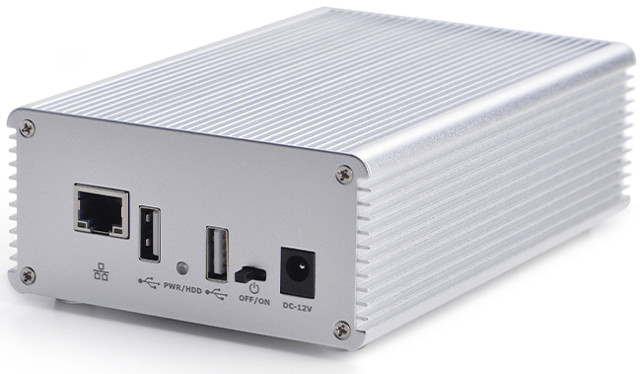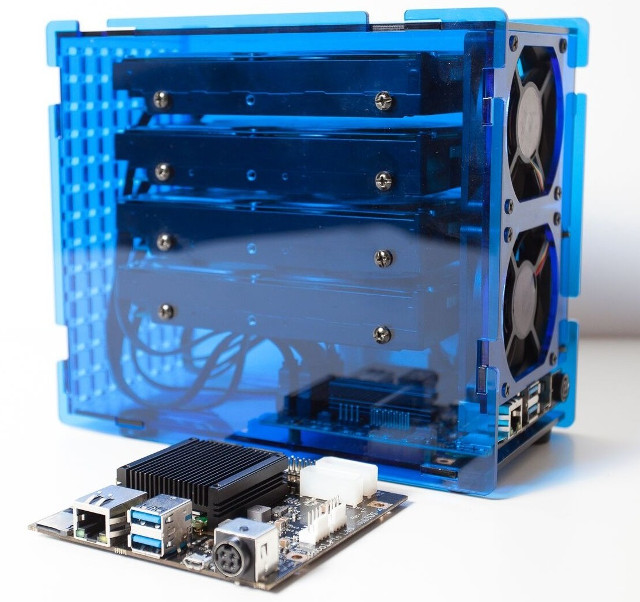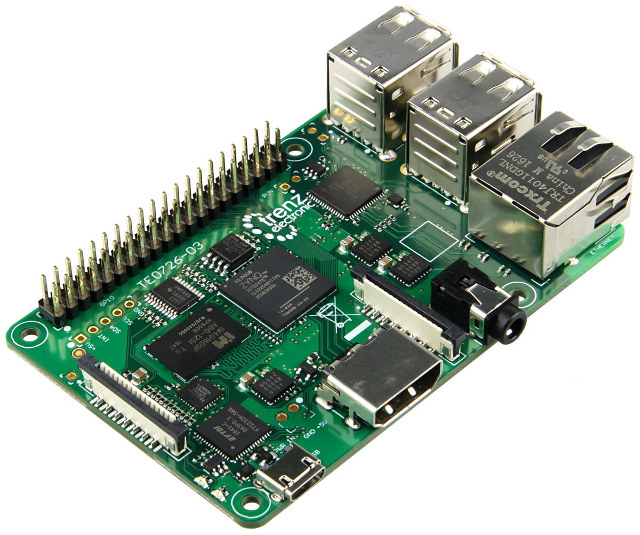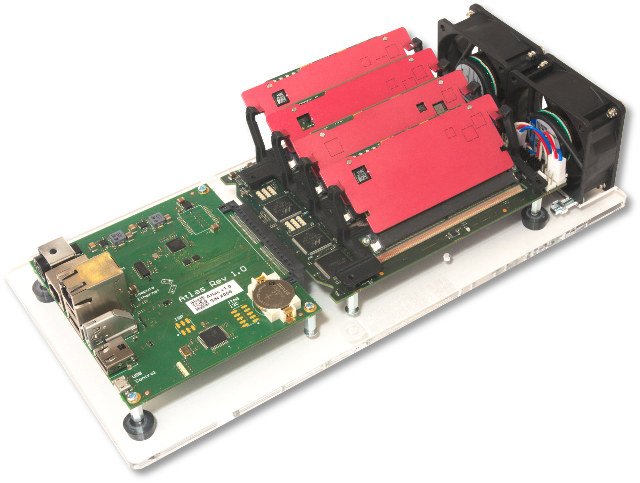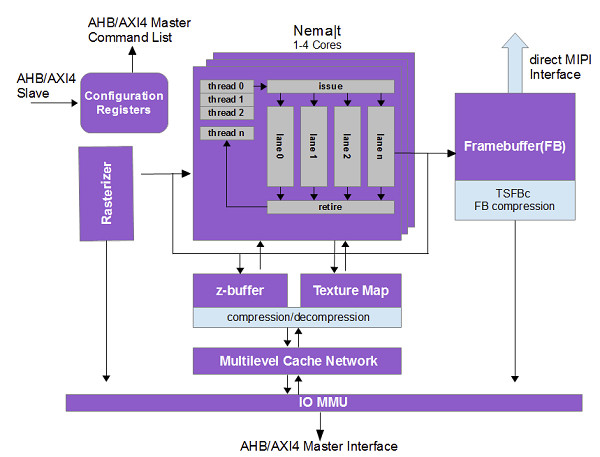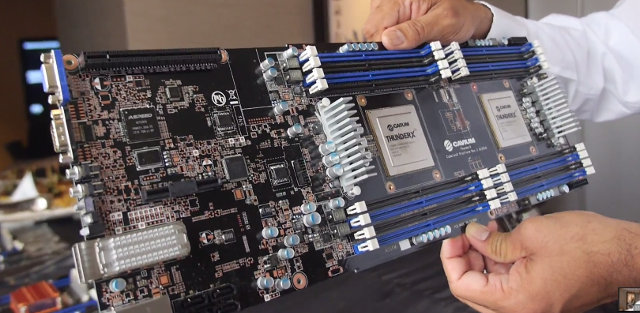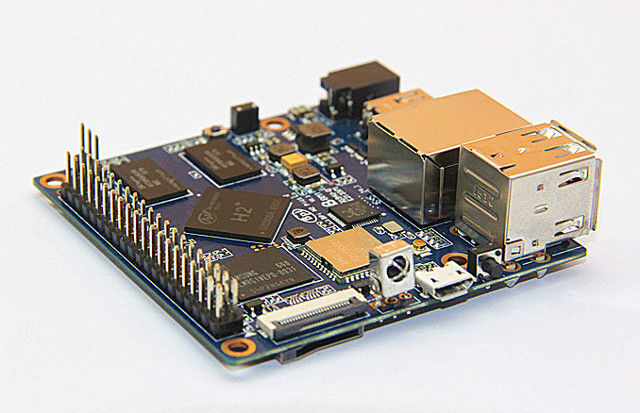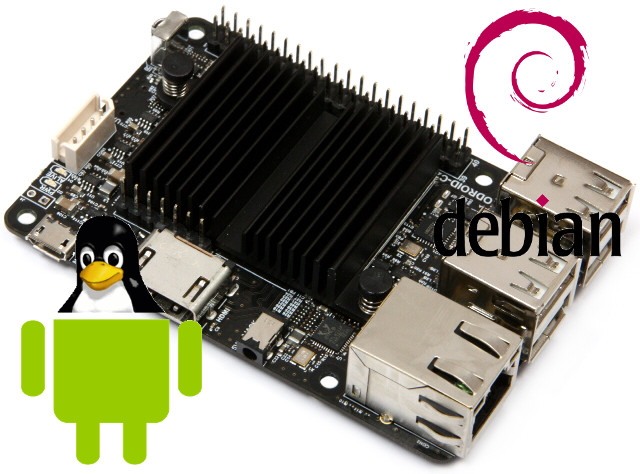Last month, FriendlyELEC launched a NAS Dock kit for NanoPi NEO board, but they’ll already removed it from their store. That’s because they have a new version NAS Dock v1.2 that also supports NanoPi NEO 2 with Gigabit Ethernet, replaces JMicron JM20329 by UAS capable JMicron JMS567 USB 3.0 to SATA bridge, and adds an RTC battery. The rest of NAS Dock Kit v1.2 specifications remain the same: 1-bay NAS Dock expansion board with JMicron JMS567 USB 3.0 to SATA bridge SATA connector for 2.5″ HDD drive Extra USB host port On/off switch, and dual color status LED Header to connect NanoPi NEO / NEO 2 board 12V DC power input Dimensions – 151 x 89.7 mm NS-120 aluminum enclosure (154 x 100 x 47.5 mm, 414 grams) Heatsink set for NanoPi NEO / NEO 2 4x M3 6mm screws, 8x M2.5 6 mm screws Four rubber pads Front and back covers […]
Helios4 Personal Cloud DIY NAS Supports 3.5″ Hard Drives, RAID, and More (Crowdfunding)
A few months ago, we covered GnuBee Personal Cloud 1, a NAS that runs on open source software, and that supports up to six 2.5″ SATA drives. The crowdfunding has been successful – after lowering the funding target -, and backers should hopefully get the NAS right after summer. But at the time, some people complained about the memory capacity (512MB), the lack of support for 3.5″ drives, and a few other items. A new project called “Helios4 Personal Cloud” addresses many of those concerns. It comes with 1 to 2GB RAM, enclosure supporting four 3.5″ drives, supports RAID, and is powered by Marvell ARMADA 388 processor that has been specifically designed for this type of application. Helios4 NAS specifications: SoC – Marvell ARMADA 388 dual core Cortex A9 processor @ up to 1.866 GHz with RAID5/6 acceleration engines, security acceleration engines, etc… System Memory – 1 or 2 GB […]
Meet Zynqberry, a Xilinx Zynq FPGA Board with Raspberry Pi 2/3 Form Factor
Earlier this year, I wrote about Trenz Electronic’s Xilinx Zynq Ultrascale+ system-on-module, but I’ve just found out I missed another interesting product from the company. The ZynqBerry is a board powered by Zilinx Zync Z-7007S or Z-7010 ARM + FPGA SoC with Raspberry Pi 2/3 form factor. ZynqBerry specifications: SoC Xilinx Zynq XC7Z007S-1CLG225C (Z-7007S) single core ARM Cortex-A9 MPCore up to 766MHz + FPGA with 23K logic cells Xilinx Zynq XC7Z010-1CLG225C (Z-7010) dual core ARM Cortex-A9 MPCore up to 866 MHz + FPGA with 28K logic cells System Memory – 128 or 512 MB DDR3L Storage – 16 MB Flash SPI flash + micro SD card slot Video Output – HDMI, MIPI DSI interface Audio Output – HDMI, 3.5mm audio jack (PWM audio only) Connectivity – 100 MBit Ethernet via (LAN9514 USB Hub with Ethernet USB – 4x USB 2.0 host ports Camera – MIPI CSI-2 interface Expansion – 40-pin Raspberry […]
Christmann RECS|Box Atlas Quad Apalis Microserver Evaluation Kit Supports Four Toradex Apalis SoM
System-on-modules are normally used in low volume embedded systems, but they can also be used in microservers, for example to upgrade capacity as needed. Christmann informationstechnik + medien GmbH has developed a microserver evaluation kit taking up to 4 Toradex Apalis SoMs for example based on Nvidia Tegra K1 processor, and also offers full rack systems with up to 72 modules. Christmann RECS|Box Atlas Quad Apalis specifications: Modules – 4x Slots for Apalis SoM Connectivity – 1 GBit/s Compute Ethernet, 1 GBit/s Management Ethernet Video Output – 1x HDMI USB – 3x USB host ports, 1x micro USB port Misc – 5 Status LEDs for USB, communication, and serial console, 4x fan connectors, KWM switch, 5x temperature sensors, 6x current sensors, 1x voltage monitor, fan speed monitoring Power Supply – 12V via a 4-pin jack Dimensions – 300 x 145 x 68 mm The evaluation kit includes an Atlas board […]
Think Silicon Ultra Low Power NEMA GPUs are Designed for Wearables and IoT Applications
When you have to purchase a wearable device, let’s say a smartwatch or fitness tracker, you have to make trade offs between user interface and battery life. For example, a fitness tracker such as Xiaomi Mi Band 2 will last about 2 weeks per charge with a limited display, while Android smartwatches with a much better interface need to be recharged every 1 or 2 days. Think Silicon aims to improve battery life of the devices with nicer user interfaces thanks to their ultra-low power NEMA 2D, 3D, and GP GPU that can be integrated into SoCs with ARM Cortex-M and Cortex-A cores. The company has three family of GPUs: NEMA|p pico 2D GPU with one core 4bpp framebuffer, 6bpp texture with/out alpha Fill Rate – 1pixel/cycle Silicon Area – 0.07 mm2 with 28nm process Power Consumption – leakage power GPU consumption of 0.06mW; with compression (TSFSc): 0.03 mW NEMA|t […]
Packet 96-core Cavium ThunderX Baremetal ARMv8 Servers are Available for $0.50 per Hour, $372 per Month
Last week, I wrote about Scaleway ARMV8 cloud servers powered by Cavium ThunderX processors. They are very cheap, as low as 0.0006 Euros per hour or 2.99 Euros per month, but you only get access to 2 to 8 cores, so obviously you don’t get a baremetal server for that price. If you want the latter Packet.net has been offering just that since the end of last year with their Type 2A baremetal server with two Cavium ThunderX 48-core processors, 128 GB RAM, 384 GB SSD and 20 Gbps bandwidth. The servers can currently run Centos 7, CoreOS, Ubuntu 16.04 LTS, with support for container platforms such as CoreOS Tectonic, Rancher, Docker Cloud, ContainerShip, StackEngine, Docker Machine, etc… You can check the status for other operating systems and features and the roadmap page. They also have x86 servers, and I’ve included the hourly and monthly prices and features for all […]
SinoVoIP Releases $35 Banana Pi BPI-M2+ Board with Allwinner H2+ Processor
Banana Pi BPI M2+ board was first released with Allwinner H3 processor, but the same PCB can also be used with Allwinner H2+ and H5 processors since the processors are pin-to-pin compatible, and SinoVoIP intends to release three version of the board, and just launched BPI M2+ (aka BPI H2+) with Allwinner H2+ processor for $34.50 + shipping, $1.5 cheaper than the H3 version also listed on Aliexpress. If you shop around, and don’t order on the official SinoVoIP store, you may find cheaper price for the boards. As expected, the specifications have not changed apart from the processor: SoC – Allwinner H2+ quad core Cortex A7 @ 1.2 GHz with an ARM Mali-400MP2 GPU up to 600 MHz System Memory – 1GB DDR3 Storage – 8GB eMMC flash, micro SD card slot up to 64GB, Video & Audio Output – HDMI with CEC support Connectivity – Gigabit Ethernet, 802.11 […]
VolksPC OS Runs Android and Debian Simultaneously on ODROID-C2 Board
Most development boards and some TV boxes offer a dual boot image with Android and a Linux distribution. To run an Android app, you need to boot to Android OS, and if you decided you need to run Linux, you then need to reboot to the Linux OS, and you can’t simply use Alt+Tab to easily and quickly switch between Android and Linux apps. But VolksPC offers just that: the ability to run Android and Debian side-by-side, and I tested their MicroXWin unified distributions with MK808B TV stick powered by Rockchip RK3066 processor a few years ago. It was early stage at the time (July 2014), and there was some stability issues.The company has kept working on their solution, but focused on more powerful hardware, and they have now released VOLKSPC OS for ODROID-C2 with Debian XFCE and Android Marshmallow, which will run both Android and Debian applications at the […]


